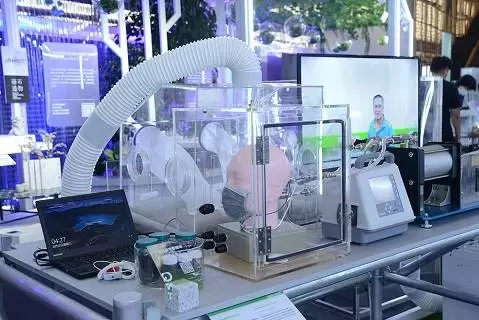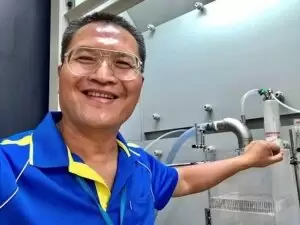
Views: 6
– The Dual Pathogen-Killing Air Purifier is integrated with the SARS Aerosol Scavenger to sterilize the air in the chamber.
Courtesy ITRI by Dr. Shou-Nan Li: COVID-19 virus is highly contagious, which puts a lot of mental pressure and physical stress on the frontline medical staff, said Dr. Ssu-Hung Wang, Superintendent of Yumin Hospital, at our first cooperation meeting this March. It was his concern that affirmed my determination to develop a solution to protect health workers.
Both COVID-19 virus and SARS (Severe Acute Respiratory Syndrome) are caused by coronaviruses and may spread through aerosol transmission. This prompted me to combine the SARS Aerosol Scavenger, an ITRI innovation developed years ago, with the newly-invented Dual Pathogen-Killing Air Purifier to form a negative-pressure sterilization system. It is expected that the novel combination can safely isolate medical staff from patients’ droplets to avoid possible infection during acute treatment.
To check the feasibility of my idea and the needs of medical personnel, I approached Dr. Wang from Yumin Hospital, which is located near ITRI’s Central Region Campus in Nantou, Taiwan. Dr. Wang was very excited about our solution and expressed medical workers’ worries about carrying out high-risk tasks such as swab-sampling and endo-intubation. Based on his experience sharing and valuable suggestions, our research team quickly designed and constructed a ventilation hood for endo-intubation and a separation chamber for swab-sampling in two months.
To completely prevent the fugitive viruses from escaping to the ambient environment, the upper hood and the chamber are individually connected to the dual-sterilizing air purifiers, which include an UVC lamp, a HEPA filter, an oxygen-rich carbonized biomaterial filter and a blower. Virus released from the patient’s mouth and nose will be sucked to the HEPA filter and then inactivated (or killed) by both the UVC light and the ozone (O3) gas around the HEPA filter. This method will be able to kill 99% of SARS and flu viruses. The sterilization efficiency has also been proved to be as high as 10E-6 to 10E-7 for E. coli and Staphylococcus aureus in a 10-minute test.
The concentration of the ozone generated by the UVC lamp is between 10 and 30 ppm, which is sufficient for effective sterilization. After sterilizing the pathogens caught by the HEPA filter, the residual ozone gas is then thoroughly converted to CO2 and O2 by oxygen-rich carbonized biomaterial. This core O3-removing biomaterial, co-developed by ITRI researchers and Professor Hong-Ping Lin from National Cheng Kung University, is produced from waste agricultural materials (e.g., water caltrop shell, rice husk, and wood) without any energy input, and can work at ambient temperature in all humidity conditions (RH=0-99%).
We hope the dual-sterilizing invention can safeguard the health of frontline medical staff in the fight against the pandemic.

From the onsite tests at Yumin Hospital, we found that the sterilization chamber could serve as an individual separation chamber in case of the lack of negative-pressure isolation rooms or can be installed in beds in mobile cabin hospitals. This dual pathogen-killing air purifier has been showcased in many public display platforms, including the Taiwan-US Cohack competition and tech exhibitions such as 2020 Discovering Technology Treasures and 2020 Taiwan Innotech Expo. It is hoped that this innovation can provide a protective shield to safeguard the health of medical staff working on the frontline.
About the author: Dr. Shou-Nan Li is a Principal Researcher working at ITRI Central Region Campus. He worked with Professor Dale Lundgren on aerosol (airborne particle) monitor and control technology during his Ph.D. studies at the University of Florida from 1993 to 1999. Then he joined ITRI and addressed issues associated with coronavirus as well as air pollutions emitting from semiconductor and optoelectronics industries. His research works have been published in more than 30 peer-reviewed journal papers and granted more than 20 patents. COVID-19 virus
Related article: Stanford – Computer model that predict how COVID-19 infections spreads